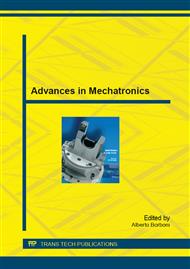[1]
A. D'Souza, S. Vijayakumar, S. Schaal: Learning inverse kinematics, International Conference on Intelligent Robots and Systems, IROS, IEEE, Maui, Hawai, USA, (2001), pp.298-303.
Google Scholar
[2]
M. Raghavan M., B. Roth: Inverse Kinematics of the General 6R Manipulator and Related Linkages, ASME Trans. J. of Mechanical Design 115 (1993) pp.502-508.
DOI: 10.1115/1.2919218
Google Scholar
[3]
A. Borboni, F. Aggogeri, R. Faglia: Fast Kinematic Model of a Seven-Bar Linkage With a Single Compliant Link, Proceeding of 12th Biennial Conference on Engineering Systems Design and Analysis, Volume 3, (2014).
DOI: 10.1115/esda2014-20076
Google Scholar
[4]
S. Kumar, N. Patel, L. Behera: Visual motor control of a 7 dof robot manipulator using function decomposition and sub-clustering in configuration, Neural Processing Letters 28 (1), (2008), pp.17-33.
DOI: 10.1007/s11063-008-9079-8
Google Scholar
[5]
F. Aggogeri, F. Al-Bender, B. Brunner, M. Elsaid, M. Mazzola, A. Merlo, D. Ricciardi, M. de la O Rodriguez, E. Salvi: Design of piezo-based AVC system for machine tool applications, Mechanical Systems and Signal Processing, Vol. 36 (2013), pp.53-65.
DOI: 10.1016/j.ymssp.2011.06.012
Google Scholar
[6]
F. Aggogeri, A. Borboni, R. Faglia, A. Merlo, S. De Cristofaro: Precision Positioning Systems: An overview of the state of art, Applied Mechanics and Materials 336-338 (2013), pp.1170-1173.
DOI: 10.4028/www.scientific.net/amm.336-338.1170
Google Scholar
[7]
T.C. Hsia, Z.Y. Guo: New inverse kinematic algorithms for redundant robots, Journal of Robotics Systems 8 (1), (1991), pp.117-132.
DOI: 10.1002/rob.4620080108
Google Scholar
[8]
G. Tevatia, S. Schaal: Inverse kinematics of humanoid robots, in: Proc. of IEEE Int. Conf. on Robotics and Automation, San Francisco, CA, (2000), pp.294-299.
DOI: 10.1109/robot.2000.844073
Google Scholar
[9]
A. Borboni, R. Faglia, G. Resconi, M. Tiboni: Kinematic Synthesis and Analysis in robotics by the morphogenetic neuron, Proceedings of EuroCast 2001 Conference, (2001).
DOI: 10.1007/3-540-45654-6_28
Google Scholar
[10]
F. Aggogeri, A. Borboni, R. Faglia: Reliability roadmap for mechatronic systems, Applied Mechanics and Materials 373-375 (2013), pp.130-133.
DOI: 10.4028/www.scientific.net/amm.373-375.130
Google Scholar
[11]
A. A. H. Sallam, W. M. F. Abouzaid: NXT* SCARA Model Based Design Controlled by Neural Network, International Journal of Control Science and Engineering 3(3) (2013), pp.86-94.
Google Scholar
[12]
P.J. Alsina, N.S. Gehlot: Robot inverse kinematics: a modular neural network approach, Proceedings of 38th Midwest Symposiumon Circuits and Systems,vol.2,(1995), p.631–634.
DOI: 10.1109/mwscas.1995.510169
Google Scholar
[13]
Y.Xia, J.Wang: A dual neural network for kinematic control of redundant robot manipulators, IEEE Transactions on Systems, Man, and Cybernetics, Part B 31(1), (2001), p.147–154.
DOI: 10.1109/3477.907574
Google Scholar
[14]
M.L. Husty, M.Pfurner and H.P. Schrocker: A new and efficient algorithm for the inverse kinematics of a general serial 6r manipulator, Mechanism and Machine Theory 42, (2007), pp.66-81.
DOI: 10.1016/j.mechmachtheory.2006.02.001
Google Scholar
[15]
P.J. Angeline, G.M. Saunders, J.B. Pollack: An evolutionary algorithm that constructs recurrent neural networks, IEEE Transactions on Neural Networks 5 (1), (1994), p.54–65.
DOI: 10.1109/72.265960
Google Scholar
[16]
S.Alavandar, M.J. Nigam: Neuro-fuzzy based approach for inverse kinematics solution of industrial robot manipulators, Int. J. of Computers, Communications & Control, 3, (2008), pp.224-234.
DOI: 10.15837/ijccc.2008.3.2391
Google Scholar
[17]
S.García, A.Fernández, J.Luengo, F.Herrera: Advanced nonparametric tests for multiple comparisons in the design of experiments in computational intelligence and data mining: experimental analysis of power, Information Sciences 180, (2010), p.2044–(2064).
DOI: 10.1016/j.ins.2009.12.010
Google Scholar
[18]
T.D. Pham: An optimally wieghted fuzzy k-NN algorithm, Proceedings of the Third International Conference on Advances in Pattern Recognition, Part I, Bath, UK, (2005), p.239–247.
Google Scholar
[19]
Y.Qu, C.Shang, Q.Shen, N.M. Parthaláin, W.Wu: Kernel-based fuzzy-rough nearest neighbour classification, IEEE International Conference on Fuzzy Systems, Taipei, Taiwan, (2011), p.1523–1529.
DOI: 10.1109/fuzzy.2011.6007401
Google Scholar
[20]
R.J. Hathaway, J.C. Bezdek, W. Pedrycz: A Parametric Model for Fusing Heterogeneous Fuzzy Data, IEEE Trans. On Fuzzy Systems 4(3) (1996), pp.270-281.
DOI: 10.1109/91.531770
Google Scholar
[21]
S.S. Rao, L.Chen: Numerical solution of fuzzy linear equations in engineering analysis, Internat.J. Numer. Methods Eng. 43, (1998), p.391–408.
DOI: 10.1002/(sici)1097-0207(19981015)43:3<391::aid-nme417>3.0.co;2-j
Google Scholar
[22]
A.S. Balu, B.N. Rao: Efficient explicit formulation for practical fuzzy structural analysis, Sadhana 36 (4), (2011), p.463–488.
DOI: 10.1007/s12046-011-0035-3
Google Scholar


